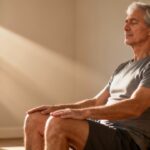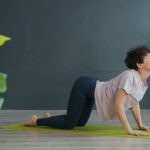What if I told you there’s a reason your body hasn’t been getting stronger? Even though you’ve been doing everything right—you walk every day, stay active, and try to eat healthier—something still doesn’t feel right. You’re losing strength. Everyday things like getting up off the couch or climbing stairs feel harder than they should.
Here’s the truth no one’s told you: after 60, your body needs a different kind of signal to build muscle. Movement alone isn’t enough, not even 10,000 steps a day. But this isn’t bad news; it’s empowering.
Today, I’m going to show you two simple movements that don’t require any gym equipment or fancy routines—movements that send a message deep into your body. It’s time to rebuild.
Exercise 1: The Wall Push That Pushes Back Time
There’s a quiet kind of strength we lose without noticing—the strength to open jars, lift ourselves from a chair, or push a door with confidence. Most people don’t realize they’re losing it until they need it.
But what if one small movement done correctly could restore that strength and reignite the connection between your body and your will?
How It Works
This simple press against a wall may seem too basic to matter, but what it triggers inside your body is profound. This movement sends mechanical signals deep into your muscle cells, prompting them to rebuild. That process is called mechanotransduction, and it’s how your body transforms effort into growth.
Unlike walking, which engages your upper body at just 20 to 30% of its potential, this exercise activates your chest, shoulders, triceps, and core at over 60% capacity. That’s real stimulation—enough to spark new muscle fibers even at 70 or 80 years old.
Benefits Beyond Strength
The benefits go beyond strength. This movement opens up your posture. As we age, gravity pulls us forward: our shoulders round, our back curves, and our lungs have less room to expand. With consistent practice, this exercise strengthens the muscles that pull your chest open and align your spine.
Better posture doesn’t just change how you look; it changes how you breathe, digest, and sleep. It also strengthens your respiratory muscles, improving oxygen flow to the brain and muscles, reducing fatigue and sharpening your mind.
How to Do Wall Push-Ups
Stand about an arm’s length away from a wall. Place your palms flat on the wall at shoulder height, fingers pointing upward. Keep your body in a straight line from head to heels, engaging your core gently.
Slowly bend your elbows, bringing your chest toward the wall. Keep your elbows at a 45° angle, not flaring out. Lower until your nose is just a few inches from the wall. Then exhale and press back to the starting position.
Start with eight to ten reps, rest for one minute, and do two to three sets three times a week. If it feels too easy, step your feet further back to increase resistance; if it’s too hard, move closer to the wall.
Exercise 2: Chair Squats That Protects Your Independence
There’s one movement that quietly determines how long you’ll be able to live independently. It’s not glamorous; it won’t get you compliments at the gym, but it may be the difference between rising on your own or relying on someone else to lift you.
This movement isn’t about fitness—it’s about freedom. It’s the ability to lower yourself and rise again. You perform it dozens of times a day without even thinking: getting up from the toilet, standing from a chair, climbing stairs.
The Science Behind Chair Squats
What makes this movement powerful is that it targets your quads, glutes, hamstrings, and calves—your entire lower chain. But more importantly, it retrains your neuromuscular memory, the pattern of sitting and standing that so many seniors begin to lose after 60.
When you do it with intention, something remarkable happens: your body releases natural growth hormones and testosterone even after 60, not from supplements or pills, but because your brain recognizes this movement as essential for survival.
In fact, a study published in the International Journal of Environmental Research and Public Health tracked 200 seniors over 16 weeks. Those who performed this movement four times per week gained nearly four pounds of lean muscle—not fat, muscle. Even more impressive, their risk of falling dropped by 50%.
How to Do Chair Squats
Find a sturdy, non-slippery chair. Stand directly in front of it with your feet shoulder-width apart, toes slightly turned outward. Extend your arms straight ahead at shoulder height for balance.
Now imagine sitting in slow motion: push your hips back first, not your knees forward. Keep your chest lifted and eyes looking ahead. Lower yourself until your bottom barely touches the chair—don’t collapse. Pause, then drive through your heels and rise with intention. Squeeze your glutes at the top.
Start with eight to ten reps, rest for 90 seconds, and perform two to three sets four times a week. If you need to sit fully between reps in the beginning, that’s okay. Progress happens in small wins.
Practical Advice for Older Adults
If you’re over 60, let me tell you something simple but powerful. You don’t need to train harder; you just need to train smarter. Muscle loss with age isn’t a life sentence; it’s a signal, a nudge from your body saying, “I need you to pay attention.”
And the best way to respond isn’t extreme workouts or trendy diets—it’s consistency. Thoughtful, gentle consistency. Two or three short sessions a week of focused movements like the ones I just showed you can bring back strength, stability, and confidence—not overnight, but certainly over time.
Remember, muscle isn’t built in the gym; it’s built in the kitchen and during rest. Make sure you’re eating enough protein spread throughout the day, drinking water, sleeping well, and giving your body time to recover. These are the real building blocks of lifelong strength.
Avoid comparing yourself to your younger self or anyone else. At this stage of life, function beats form. If you can move with control, stand with ease, and live with less pain, that’s success. Don’t chase intensity; chase quality, chase purpose, and above all, be kind to yourself.
Every rep, every breath, every attempt matters. You’re not just exercising; you’re telling your body, “I still care about you,” and your body is always listening.
Conclusion: Reclaim Your Strength and Independence
Real strength, the kind that matters most after 60, isn’t loud. It doesn’t show off; it shows up. It shows up when you stand tall after feeling unsteady, when you reach for a cabinet without fear, when you get out of a chair and no longer have to brace yourself with both hands.
That’s strength, and that’s dignity. These two simple exercises are more than just movements; they’re reminders that you are not fragile, that age may change your pace but it doesn’t erase your power, that strength is not reserved for the young—it belongs to the committed.
So today, let’s stop waiting for a better day or a perfect plan. Let’s stop saying “someday” and start saying “now.” Now is the moment to press. Now is the moment to rise. Now is the moment to begin again.








